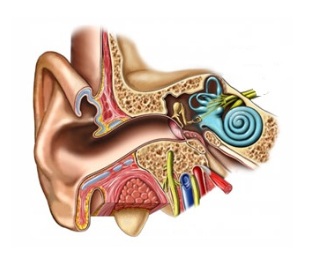Cochlear Implants
A cochlear implant is an assistive auditory device designed specifically for those who are profoundly deaf or suffer from severely impaired hearing. Sometimes referred to as a “bionic ear,” this specialized type of hearing aid works by transmitting collected sounds from an external microphone to a surgically implanted receiver, and then to the cochlea and inner-ear via a string of wired electrodes.
HOW IS A COCHLEAR IMPLANT DIFFERENT FROM A NORMAL HEARING AID?
A cochlear implant is a less flexible and more permanent assistive device than a standard hearing aid, and it is not simply “worn,” but has parts which must be surgically connected beneath the patient’s skin. Whereas a hearing aid is generally a relatively simple piece of external hardware, a cochlear implant comprises several components, both external and internal, which function together to stimulate auditory nerve function and improve the reception and separation of different sound frequencies by the user’s auditory system.
WHAT ARE THE DIFFERENT PARTS OF A COCHLEAR DEVICE AND HOW DO THEY WORK?
A cochlear implant has five essential components which function together in order to restore a level of perception to patients suffering from severe hearing loss or auditory disorder: the microphone, the speech processor, the transmitter, the receiver/stimulator, and the electrode array. Working together, these pieces create an auxiliary auditory network, which conveys environmental sound from outside of the ear, through the cochlea, and via the auditory nerve system to the brain.
The process begins with the microphone and speech processor, which are generally affixed behind the patient’s ear. The microphone collects sound waves, which are then filtered and sorted by the processor, the primary function of which is to isolate and amplify the particular frequencies of human speech. The processed information is then passed to the transmitter, an external coil secured behind the ear. Using electromagnetic induction, the transmitter relays the auditorysignals to the receiver and stimulator, implanted beneath the transmitter and secured to the skull during the surgical process. It is here, under the skin, that the collected sound data is converted into electric impulses, which are sent through a cable to the waiting electrodes affixed to the cochlea. As the electrodes fire, they stimulate tympanic nerves and are sent directly to the brain via the auditory nerve system. In this way, sounds can be collected externally, and rerouted through this surgically installed bypass to the processing receptors of the brain. This approach makes it possible to restore some level of functional hearing to individuals with non-functional middle and outer ears. While a hearing aid treatment generally seeks to improve a damaged or failing auditory system through enhancement and amplification, the cochlear implant approach seeks to establish an entirely new and improved pathway of sound.
WHAT TYPES OF HEARING LOSS ARE COCHLEAR IMPLANTS DESIGNED TO TREAT?
 Cochlear implants are a much more intensive response to hearing loss than hearing aids and other therapies, and are generally prescribed to those patients for whom less aggressive treatments have been unsuccessful or whose hearing loss is more severe and complete. The typical candidate for the procedure is an individual with profound sensorineural hearing loss, meaning that the root of the dysfunction lies in the nerves of the inner ear or the processing centers of the brain; however, if there is too much damage to the auditory nerves, the device will ultimately be unsuccessful, as the cochlear implant requires responsive nerve fibers in order to transmit the signal impulses to the brain. It is also important that the potential candidate has some previously acquired language and communication skills, or, in the case of pre-lingually deaf children, have a family that is committed to continuous development of word recognition and speech.
Cochlear implants are a much more intensive response to hearing loss than hearing aids and other therapies, and are generally prescribed to those patients for whom less aggressive treatments have been unsuccessful or whose hearing loss is more severe and complete. The typical candidate for the procedure is an individual with profound sensorineural hearing loss, meaning that the root of the dysfunction lies in the nerves of the inner ear or the processing centers of the brain; however, if there is too much damage to the auditory nerves, the device will ultimately be unsuccessful, as the cochlear implant requires responsive nerve fibers in order to transmit the signal impulses to the brain. It is also important that the potential candidate has some previously acquired language and communication skills, or, in the case of pre-lingually deaf children, have a family that is committed to continuous development of word recognition and speech.
Despite the fact that cochlear implants can restore the transmission of certain sounds to the brain, they offer no substitute for the natural development of listening and speaking skills, which explains the greater success rate of implants in children and adolescents who are still in their greatest stages of growth. Adults with severe post-lingual hearing loss may benefit from implants as well, but generally face a higher risk of surgical failure or complication, and a much harsher period of post-operative adjustment.
HOW DO I KNOW IF A COCHLEAR IMPLANT WOULD BENEFIT ME OR SOMEONE I KNOW?
Since cochlear implants require surgical alteration to the auditory system and ear, they are almost always employed in treating individuals with profound impairment or hearing loss, and often only after less invasive approaches have been attempted or dismissed. As with any concern regarding damaged or problematic hearing, the first step of the correction process should always be to contact your local audiologist for an examination and consultation. 1-888-HEAR-CLEAR can help you locate professionals in the area, who are qualified experts at diagnosing hearing disorders and scheduling personalized plans for treatment.

